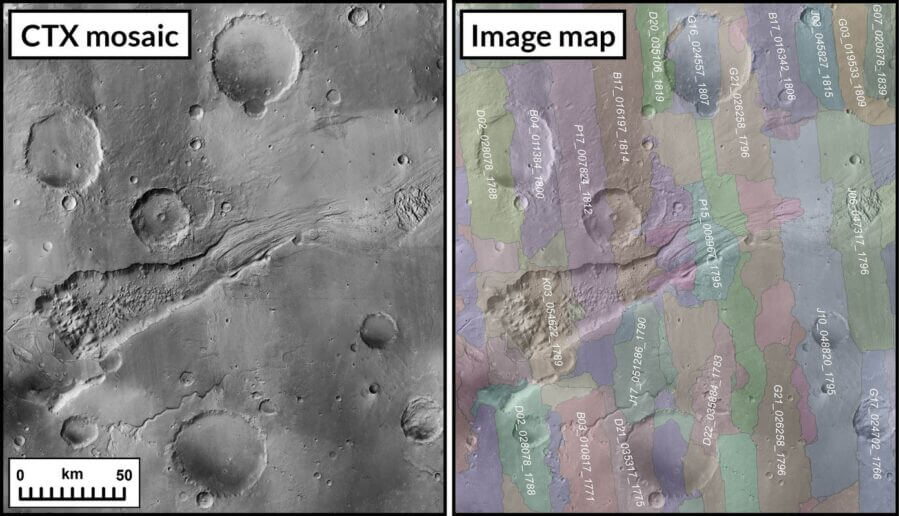A planet-spanning online image of Mars created at a scale of 5 meters per pixel was unveiled today. The image is freely available to the public and can be accessed online through Caltech’s Bruce Murray Laboratory for Planetary Visualization. It will also be delivered to the NASA Planetary Data System for posting.
The mosaicked image—comprising more than 5.7 trillion pixels (5.7 terapixels)—was generated at the Murray Lab by merging 110,000 individual images taken by the Context Camera (CTX) aboard NASA’s Mars Reconnaissance Orbiter (MRO). It covers 99.5 percent of the surface of Mars between 88° South and 88° North. (The remaining 0.5 percent either was not imaged at all or was not imaged at a high enough quality by the time the mosaic was created.)
The image took six years and tens of thousands of hours of labor to build. If it were printed out at 300 dpi (the standard printing resolution), the resulting image could be used as a sunshade for the Rose Bowl and a significant chunk of the Rose Bowl’s parking lot.
“The scale of this is really unprecedented,” says Jay Dickson, Murray Lab manager and research scientist in image processing. Dickson conceived and spearheaded the project soon after he was hired to establish the Murray Lab in 2016.
Individuals who access the image can view it on an interactive interface called SceneView developed by Esri, a geographic information system company. This interface allows for seamless exploration of the entire Red Planet at “outcrop resolution.” Outcrops are individual small cliffs and buttes that may be of interest to scientists.
“Mission data are a gift that keeps on giving. NASA’s research and analysis program allowed us complete this huge mosaic and make it universally available,” says Bethany Ehlmann, professor of planetary science and associate director of the Keck Institute for Space Studies. “I can’t wait to see everything people do with it and the science it enables.” Ehlmann and Dickson were principal investigators of the NASA Planetary Data Archiving, Restoration, and Tools grant that funded much of the work.
While scientists have higher-resolution individual images of locations on Mars, the highest resolution available at a global scale before this was 100 meters per pixel compared to 5 meters per pixel for the new mosaic. This represents a 20-fold increase in resolution in both dimensions of the Martian surface, providing 400 times more information for a given area.
To construct the image, Dickson and his colleagues used a feature-matching algorithm that aligned all of the images and blended overlapping images together by calculating the path of least contrast between those two and joining them together like jigsaw puzzle pieces. “This is nondestructive processing,” Dickson says. “We’re not blurring lines to smooth out boundaries; we’re finding the best possible line to join two images.” Importantly, a map of this jigsaw puzzle of individual images has been released along with the image, allowing complete traceability of each pixel to its parent image.
If our reporting has informed or inspired you, please consider making a donation. Every contribution, no matter the size, empowers us to continue delivering accurate, engaging, and trustworthy science and medical news. Independent journalism requires time, effort, and resources—your support ensures we can keep uncovering the stories that matter most to you.
Join us in making knowledge accessible and impactful. Thank you for standing with us!

